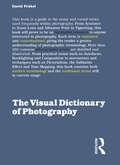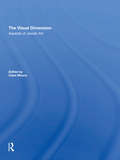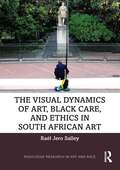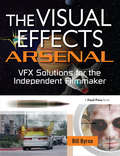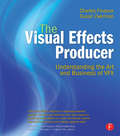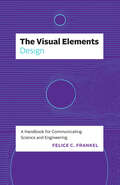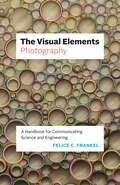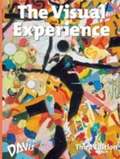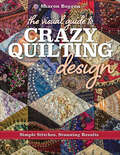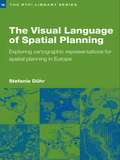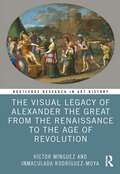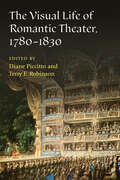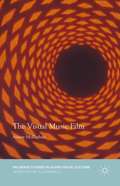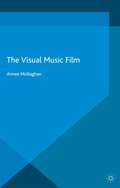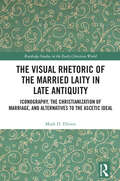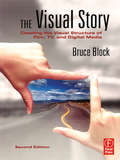- Table View
- List View
The Visual Dictionary of Photography
by David PräkelThe Visual Dictionary of Photography provides clear definitions of key terms and concepts, backed up by hundreds of illustrative examples. Covering practical terms, it deals with the terminology of both digital and traditional photography. David Präkel has produced an invaluable resource for anyone interested in photography, lens-based media and related visual arts. This book serves not only to explain terms and words but also acts as a source of inspiration, encouraging exploration through understanding.Over 250 terms are explained and contextualised, with concise definitions accompanied by illustrations and examples taken from historical and contemporary photography.The dictionary covers analogue terms still in current usage as well as modern digital terminology such as Raw format and High dynamic range. It also defines a wide variety of practical terms, including ISO speed, Backlighting and Noise, as well as conceptual terms and photographic styles, ranging from Photojournalism to Distortion.
The Visual Dimension: Aspects Of Jewish Art
by Clare MooreThis book looks at art historical explorations, matters of archival legitimacy, the survival of fakes and forgeries and many other aspects of Jewish art. It commemorates the life and work of Isaiah Shachar through the medium of papers given at the first international conference on Jewish art.
The Visual Dynamics of Art, Black Care, and Ethics in South African Art (Routledge Research in Art and Race)
by Raél Jero SalleyThis book interprets relationships between art and ethics in the context of contemporary South African art.Nearly three decades after inaugurating political freedom in a democratic form, the infrastructure of South Africa faces palpable issues and challenges to the social fabric. The social tension involves painful struggles for decolonization and violent debates about the removal of colonial statues, change of colonial names, transformation of universities, and curriculum change. This book does critical work in art history, theory, criticism, and visual culture by looking from and looking after social differences to interpret the potential impact of contemporary media and mediation. Artists examined include Zanele Muholi, Mohau Modisekeng, Dineo Seshee Bopape, Hasan and Husain Essop, and Kemang Wa Lehulere.This book will be of interest to scholars working in art history, contemporary art, visual culture, art theory, ethics, aesthetics, philosophy of art, and African studies.
The Visual Effects Arsenal: VFX Solutions for the Independent Filmmaker
by Bill ByrneBuild your VFX arsenal with quick-access, step-by-step instruction on how to create today's hottest digital VFX shots. This essential toolkit provides techniques for creating effects seen in movies such as 300, Spiderman 3, Predator and others, with lessons on how-to:* splatter blood or digitally lop someone's arm off* create a scene with actors running from an explosion* create the "twin effect" (same actor, same location, 2 performances)* produce space-ship dog fightsOrganized in a 'cookbook' style, this allows you to reference a certain effect in the index and immediately access concise instructions to create that effect. Techniques are demonstrated in each of the most popular software tools- After Effects, Final Cut Studio, Photoshop, and Combustion are all covered. Brilliant, 4-color presentation provides inspiration and stimulating visual guidance to the lessons presented, while the downloadable resources contain project media files enabling you to put concepts learned into immediate practice.
The Visual Effects Producer: Understanding the Art and Business of VFX
by Susan Zwerman Charles FinanceFirst published in 2010. Routledge is an imprint of Taylor & Francis, an informa company.
The Visual Elements—Design: A Handbook for Communicating Science and Engineering (The Visual Elements)
by Felice C. FrankelWith insights and examples from designers at publications from Nature to the New York Times, an essential guide to creating figures and presentations. In this short handbook, award-winning science communicator Felice C. Frankel offers a quick guide for scientists and engineers who want to share—and better understand—their research by designing compelling graphics for journal submissions, grant applications, presentations, and posters. Like all the books in the Visual Elements series, this handbook is also a training tool for researchers. Distilling her celebrated books and courses to the essentials, Frankel shows scientists and engineers, from students to primary investigators, the importance of thinking visually. This crucial volume in the Visual Elements series offers a wealth of engaging design examples. Case studies and advice from designers at prestigious publications and researchers’ own before-and-after examples show how even the smallest changes—to color, type, composition, and layering—can greatly improve communication. Ideal for researchers who want a foothold for presenting and preparing their work for everything from conferences to publications, the book explains the steps for creating a concise and communicative graphic to highlight the most important aspects of research—and to clarify researchers’ own thinking. The resulting book is an essential element of any scientist’s, engineer’s, or designer’s library.
The Visual Elements—Photography: A Handbook for Communicating Science and Engineering (The Visual Elements)
by Felice C. FrankelFor novice or pro, primary investigator or postdoc, the essentials for photographing science and technology for journals, grant applications, and public understanding. Award-winning photographer Felice C. Frankel, whose work has graced the covers of Science, Nature,and Scientific American, among other publications, offers a quick guide for scientists and engineers who want to communicate—and better understand—their research by creating compelling photographs. Like all the books in the Visual Elements series, this short guide uses engaging examples to train researchers to learn visual communication. Distilling her celebrated books and courses to the essentials, Frankel shows scientists and engineers the importance of thinking visually. When she creates stunning images of scientific phenomena, she is not only interested in helping researchers to convey understanding to others in their research community or to gain media attention, but also in making these experts themselves “look longer” to understand more fully. Ideal for researchers who want a foothold for presenting and preparing their work for conferences, journal publications, and funding agencies, the book explains four tools that all readers can use—a phone, a camera, a scanner, and a microscope—and then offers important advice on composition and image manipulation ethics. The Visual Elements—Photography is an essential element in any scientist’s, engineer’s, or photographer’s library.
The Visual Experience
by Jack Hobbs Ken Vieth Richard SalomeLEVEL: Key Stage 4 onwards. A comprehensive art appreciation program, 'The Visual Experience' is a complete visual art curriculum that integrates art history, aesthetics, criticism, and production. The third edition has: All new studio experiences; More artists biographies; More contemporary art; Step-by-step art criticism in every major chapter; Writing emphasised throughout.
The Visual Experience
by Jack Hobbs Ken Vieth Richard SalomeLEVEL: Key Stage 4 onwards. A comprehensive art appreciation program, 'The Visual Experience' is a complete visual art curriculum that integrates art history, aesthetics, criticism, and production. The third edition has: All new studio experiences; More artists biographies; More contemporary art; Step-by-step art criticism in every major chapter; Writing emphasised throughout.
The Visual Experience (2nd Edition)
by Jack Hobbs Richard SalomeDesigned for students, this volume explores the expression and construction of art, and discusses the creative and technical processes of art. The book consists of different elements that will help you understand what art is, how it is made, and how it can make your life richer.
The Visual Guide to Crazy Quilting Design: Simple Stitches, Stunning Results
by Sharon BoggonSee it, stitch it! Thirty-five contemporary crazy-quilting stitches, photographed step by step. Rooted in the Victorian era, crazy quilting has a powerful allure for today's quilters, who use it to let loose and tell a unique story with fabric. Embrace crazy quilting with thirty-five must-know stitches and endless variations, shown in clear, step-by-step photographs for both right- and left-handed stitchers. Fine artist Sharon Boggon reveals design fundamentals to guide you in your process, so you can sew thoughtful, visually appealing blocks. Learn the theory and process behind this fascinating art: how to choose fabrics, piece stitch-and-flip blocks, and embellish seams with embroidery, beads, buttons, and charms. • Learn crazy-quilting techniques with colorful photos that show every detail • Combine fabric, embellishments, and thirty-five stitches, plus endless variations, into stunning crazy quilts as unique as you • Unpack savvy design principals to make order of the chaos and guide the viewer's eye around the block
The Visual Language of Spatial Planning: Exploring Cartographic Representations for Spatial Planning in Europe (RTPI Library Series)
by Stefanie DührAt a time when strategic spatial planning is undergoing a renaissance in Europe, The Visual Language of Spatial Planning makes a unique contribution to this rapidly growing area of teaching and research. Discussing the relevant theoretical perspectives on policy-making and planning, combined with cartographic communication and the use of cartographic representations in the planning process, Stephanie Duhr provides conceptual and practical tools to help students and practitioners better understand maps and visualizations in strategic spatial planning. The book is the first to review the form, style and use of cartographic representations in strategic spacial plans in the Netherlands, Germany and England as well as at European level. Significant differences between planning traditions and the impact of these on transnational planning processes are highlighted. It concludes by discussing the practical implications for future strategic spacial planning processes in Europe and the best use of cartographic representations to reach agreement and to focus dialogue.
The Visual Language of Technique
by Luigi CocchiarellaThe book is inspired by the third seminar in a cycle connected to the celebrations of the 150th anniversary of the Politecnico di Milano (July 2013). "Educating by Image. Teaching Styles vs Learning Styles" was the motto of this meeting. The contributions (coming from lectures, the poster session, interviews and round table) aim to propose an updated look at visual education, highlighting how digital tools and networks have profoundly affected the "representational styles" of the teachers and the "cognitive styles" of the learners, while at the same time reaffirming the importance of the interaction between the two groups. As Herbert Alexander Simon once said, "Learning results. . . only from what the student does and thinks"; therefore "the teacher can advance learning only by influencing what the student does to learn". That is no mean feat if we consider that, according to Benjamin Samuel Bloom, visual education not only involves the pure cognition, but also the affective and the psychomotor domains, not to mention the social aspects. This is why, alongside some theoretical and historical retrospectives, the contributions recommend a continuous revision of "what" and "how" could be included in the academic curricula, also in connection with secondary schools, the professional world, targeted Lifelong Learning Programmes for students and teachers. The volume includes an interview with the science journalist and writer Piero Angela.
The Visual Legacy of Alexander the Great from the Renaissance to the Age of Revolution (Routledge Research in Art History)
by Víctor Mínguez Inmaculada Rodríguez-MoyaThis is an analysis of the diverse facets of Alexander the Great’s image from the Renaissance era through the Baroque into the nineteenth century. Perceived as the first sovereign ruler of the world, for centuries Alexander became an exemplar for the most ambitious kings and emperors. This cultural phenomenon flourished above all in the Renaissance while extending into the nineteenth century. Early modern monarchs’ identification with Alexander associated them with ideas of kingly wisdom. Yet this admiration waned on occasions. Napoleon was Alexander of Macedonia’s most ardent critic. During the nineteenth century, the Macedonian hero was viewed as an individual who won control of the Achaemenid empire, but also underwent a progressive moral decline that converted him into a tyrant. The book will be of interest to scholars working in art history and iconography.
The Visual Life of Romantic Theater, 1780-1830
by Diane Piccitto Terry F. RobinsonThe Visual Life of Romantic Theater examines the dynamism and vibrancy of stage spectacle and its impact in an era of momentous social upheaval and aesthetic change. Situating theatrical production as key to understanding visuality ca. 1780-1830, this book places the stage front and center in Romantic scholarship by re-envisioning traditional approaches to artistic and social creation in the period. How, it asks, did dramaturgy and stagecraft influence aesthetic and sociopolitical concerns? How does a focus on visuality expand our understanding of the historical experience of theatergoing? In what ways did stage performance converge with visual culture beyond the theater? How did extratheatrical genres engage with theatrical sight and spectacle? Finally, how does a focus on dramatic vision change the way we conceive of Romanticism itself? The volume’s essays by emerging and established scholars provide exciting and suggestive answers to these questions, along with a more capacious conception of Romantic theater as a locus of visual culture that reached well beyond playhouse walls.
The Visual Music Film (Palgrave Studies in Audio-Visual Culture)
by Aimee MollaghanAdopting an interdisciplinary approach, The Visual Music Film explores the concept and expression of musicality in the visual music film, in which visual presentations are given musical attributes such as rhythmical form, structure and harmony.
The Visual Music Film (Palgrave Studies in Audio-Visual Culture)
by Aimee MollaghanAdopting an interdisciplinary approach, The Visual Music Film explores the concept and expression of musicality in the visual music film, in which visual presentations are given musical attributes such as rhythmical form, structure and harmony.
The Visual Rhetoric of the Married Laity in Late Antiquity: Iconography, the Christianization of Marriage, and Alternatives to the Ascetic Ideal (Routledge Studies in the Early Christian World)
by Mark D. EllisonThis study examines third- and fourth-century portraits of married Christians and associated images, reading them as visual rhetoric in early Christian conversations about marriage and celibacy, and recovering lay perspectives underrepresented or missing in literary sources. Historians of early Christianity have grown increasingly aware that written sources display an enthusiasm for asceticism and sexual renunciation that was far from representative of the lives of most early Christians. Often called a “silent majority,” the married laity in fact left behind a significant body of work in the material record. Particularly in and around Rome, they commissioned and used such objects as sarcophagi, paintings, glass vessels, finger rings, luxury silver, other jewellery items, gems, and seals that bore their portraits and other iconographic forms of self-representation. This study is the first to undertake a sustained exploration of these material sources in the context of early Christian discourses and practices related to marriage, sexuality, and celibacy. Reading this visual evidence increases understanding of the population who created it, the religious commitments they asserted, and the comparatively moderate forms of piety they set forth as meritorious alternatives to the ascetic ideal. In their visual rhetoric, these artifacts and images comprise additional voices in Late Antique conversations about idealized ways of Christian life, and ultimately provide a fuller picture of the early Christian world. Plentifully illustrated with photographs and drawings, this volume provides readers access to primary material evidence. Such evidence, like textual sources, require critical interpretation; this study sets forth a careful methodology for iconographic analysis and applies it to identify the potential intentions of patrons and artists and the perceptions of viewers. It compares iconography to literary sources and ritual practices as part of the interpretive process, clarifying the ways images had a rhetorical edge and contributed to larger conversations. Accessibly written, The Visual Rhetoric of the Married Laity in Late Antiquity is of interest to students and scholars working on Late Antiquity, early Christian and late Roman social history, marriage and celibacy in early Christianity, and early Christian, Roman, and Byzantine art.
The Visual Story: Creating the Visual Structure of Film, TV and Digital Media
by Bruce BlockIf you can't make it to one of Bruce Block's legendary visual storytelling seminars, then you need his book! Now in full color for the first time, this best-seller offers a clear view of the relationship between the story/script structure and the visual structure of a film, video, animated piece, or video game. You'll learn how to structure your visuals as carefully as a writer structures a story or a composer structures music. Understanding visual structure allows you to communicate moods and emotions, and most importantly, reveals the critical relationship between story structure and visual structure.The concepts in this book will benefit writers, directors, photographers, production designers, art directors, and editors who are always confronted by the same visual problems that have faced every picture maker in the past, present, and future.
The Visual Story: Creating the Visual Structure of Film, TV, and Digital Media
by Bruce BlockThis updated edition of a best-selling classic shows you how to structure your visuals as carefully as a writer structures a story or composers structure their music. The Visual Story teaches you how to design and control the structure of your production using the basic visual components of space, line, shape, tone, color, movement, and rhythm. You can use these components to effectively convey moods and emotions, create a visual style, and utilize the important relationship between the visual and the story structures. Using over 700 color illustrations, author Bruce Block explains how understanding the connection between story and visual structures will guide you in the selection of camera angles, lenses, actor staging, composition, set design and locations, lighting, storyboard planning, camera coverage, and editing. The Visual Story is an ideal blend of theory and practice. The concepts and examples in this new edition will benefit students learning cinematic production, as well as professional writers, directors, cinematographers, art directors, animators, game designers, and anyone working in visual media who wants a better understanding of visual structure.
The Visual is Political: Feminist Photography and Countercultural Activity in 1970s Britain
by Na'Ama Klorman-EraqiThe Visual is Political examines the growth of feminist photography as it unfolded in Britain during the 1970s and 1980s. This period in Britain was marked by instability following the collapse of the welfare state, massive unemployment, race riots, and workers’ strikes. However, this was also a time in which various forms of social activism emerged or solidified, including the Women’s Movement, whose members increasingly turned to photography as a tool for their political activism. Rather than focusing on the aesthetic quality of the images produced, Klorman-Eraqi looks at the application of feminist theory, photojournalism, advertising, photo montage, punk subculture and aesthetics, and politicized street activity to emphasize the statement and challenge that the photographic language of these works posed. She shows both the utilitarian uses of photography in activism, but also how these same photographers went on to be accepted (or co-opted) into the mainstream art spaces little by little, sometimes with great controversy. The Visual is Political highlights the relevance and impact of an earlier contentious, creative, and politicized moment of feminism and photography as art and activism.
The Vital Landscape: Nature and the Built Environment in Nineteenth-Century Britain
by William M. TaylorThe Vital Landscape explores the arrival of the biological sciences - most notably the sciences oflife entailed in studies of botany and zoology, ecology and evolutionary science, physiology and psychology - in the nineteenth century and their impact on architecture and landscape architecture in Great Britain. Specifically, the book explores the idea of the contrived or artificial environment as an object of both scientific speculation and aesthetic reflection. Unlike specialist histories of biological science or environmental thought, this book is unique in locating one source for present-day concerns for the environment and human well-being in debates over proper housing and the growing popularity of domestic and public gardens in the nineteenth century. The book skilfully interweaves architecture and garden history, the history and philosophy of science, plant and animal physiology and human psychology, works of literature, popular science and domestic economy in a story that opens new opportunities for the study of architecture and gardens.
The Voice Book: Revised Edition
by Michael McCallionA practical manual for voice users of all kinds, The Voice Book is written by one of the world's leading voice teachers. Michael McCallion has spent over 35 years training various professionals, from performers to auctioneers, how to use their voice. Used throughout the world in actor training and as suggested reading for lawyers, the earlier edition of The Voice Book became the classic work on using one's voice. It has now been revised to make use of the feedback from numerous readers of the earlier edition. Clearly written and easy to use, McCallion covers everything from Body Use and Breathing, to Tuning and Voice Energy. Whether you are a professional or amateur actor, a classical or popular singer, a teacher, or need to present for business, The Voice Book will help you discover how to use your voice freely, powerfully and with pleasure.
The Voice Coach's Toolkit (The Focal Press Toolkit Series)
by Pamela PratherThe Voice Coach's Toolkit identifies the primary professional vocal coaching opportunities and the avenues by which a student or early career coach can navigate the vocation. For purposes of this book, the Voice Coach is defined as someone who coaches the spoken voice in three precise areas: the teaching artist, the professional film/TV/theatre coach, and the professional voice-user coach. These three coaching worlds are broadly defined and each area includes in-depth interviews and practical advice from top coaches along with the author’s personal expertise. The book can be read in sections or as a whole, making it as useful for early career coaches as it is for those looking to expand their vocal coaching career or vocal pedagogy students who need a broad survey of all three areas.
